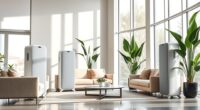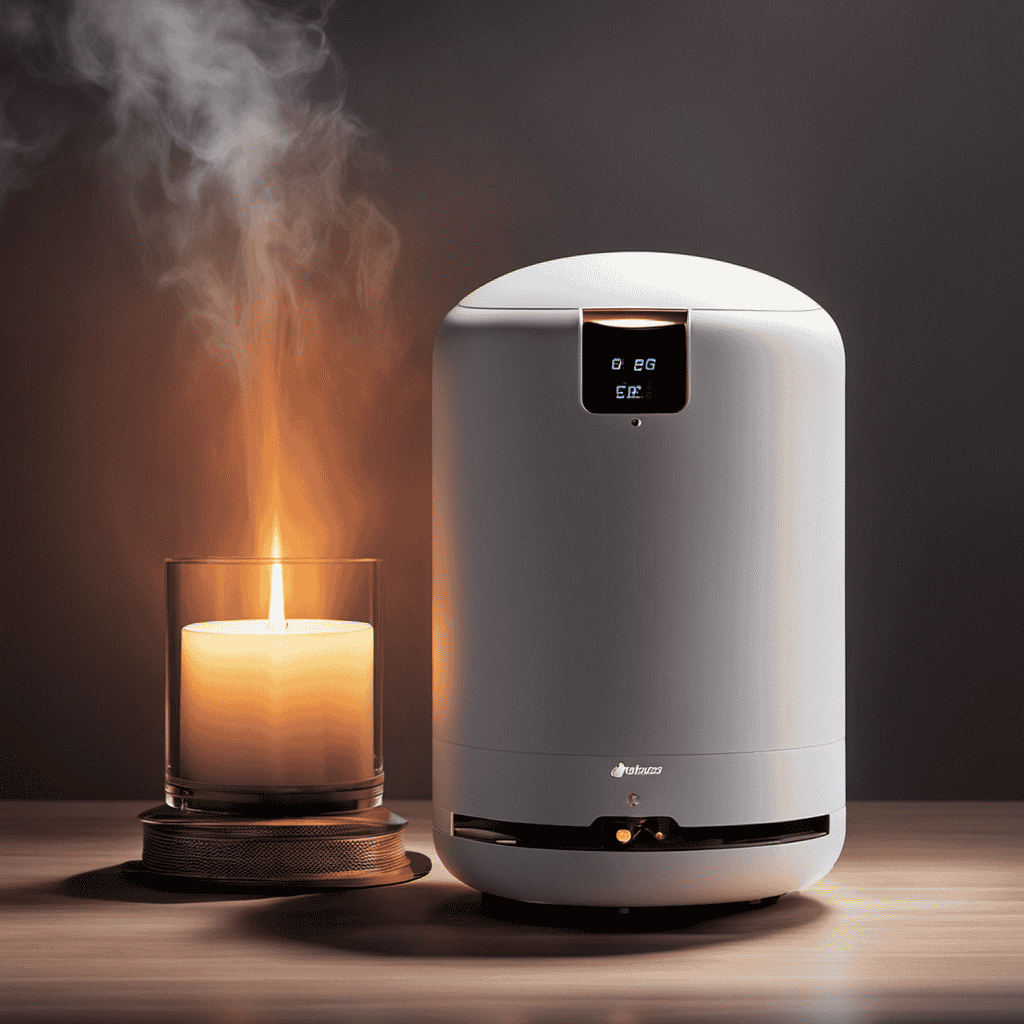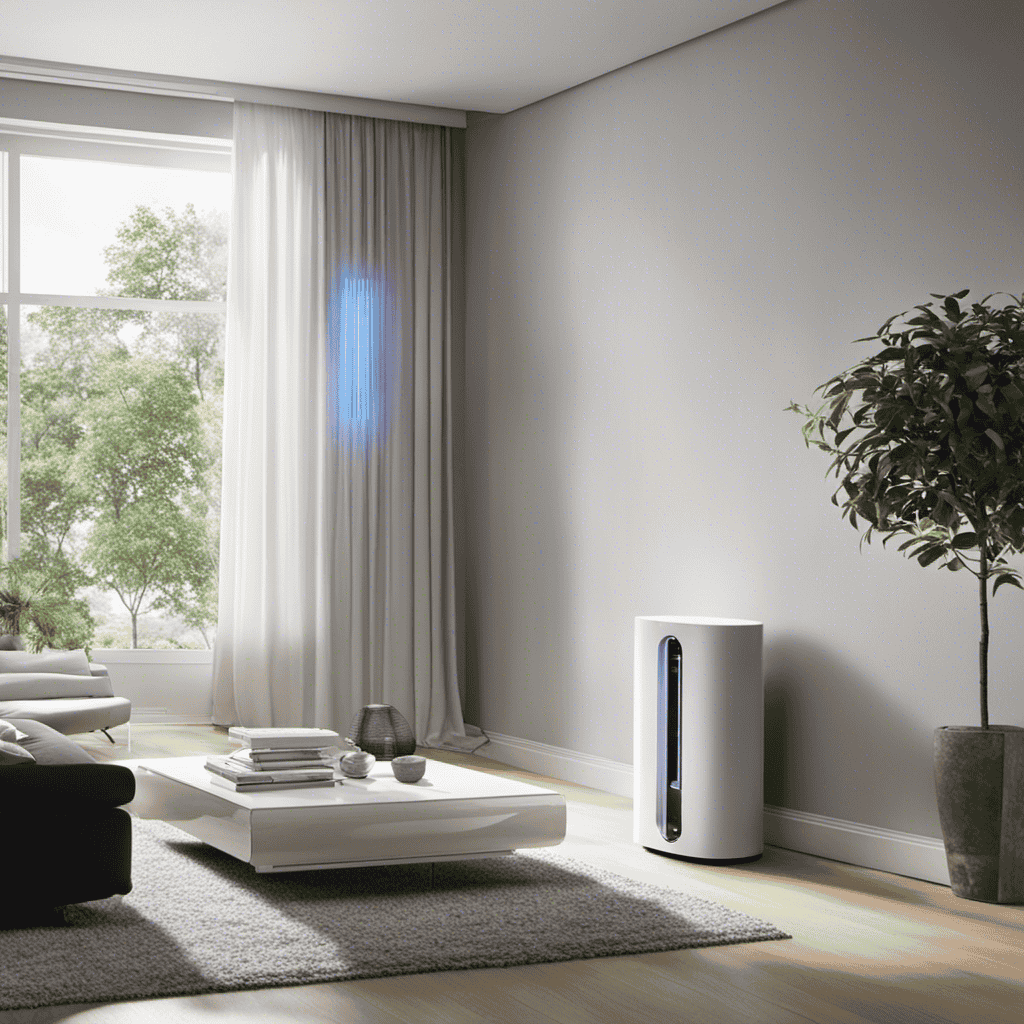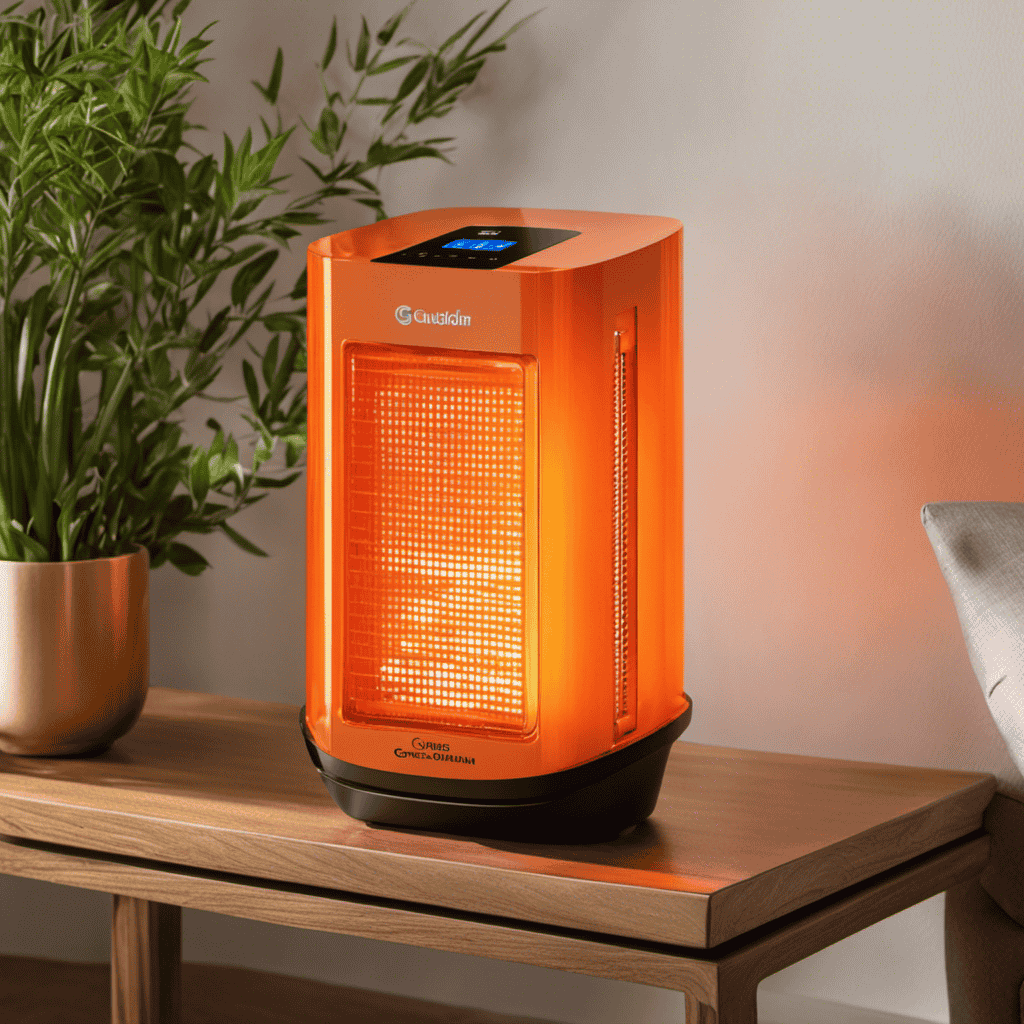Ionizer air purifiers can improve your indoor air quality by removing airborne particles, but many produce ozone, which can harm your health. Ozone is a reactive molecule that irritates your respiratory system and worsens air quality, especially in enclosed spaces. Not all ionizers emit dangerous levels of ozone, so it’s crucial to choose models with low or zero ozone output and follow safety guidelines. To learn more about keeping your air safe, continue exploring what you need to know.
Key Takeaways
- Many ionizer air purifiers produce low or safe levels of ozone, but some models can emit harmful amounts.
- Safety depends on device certification; look for labels from agencies like CARB or UL.
- Proper ventilation and room size management help prevent ozone buildup indoors.
- Regular maintenance reduces the risk of increased ozone emissions from aging components.
- Always verify ozone emission levels and choose devices within safe standards to ensure safe use.
How Do Ionizer Air Purifiers Work?
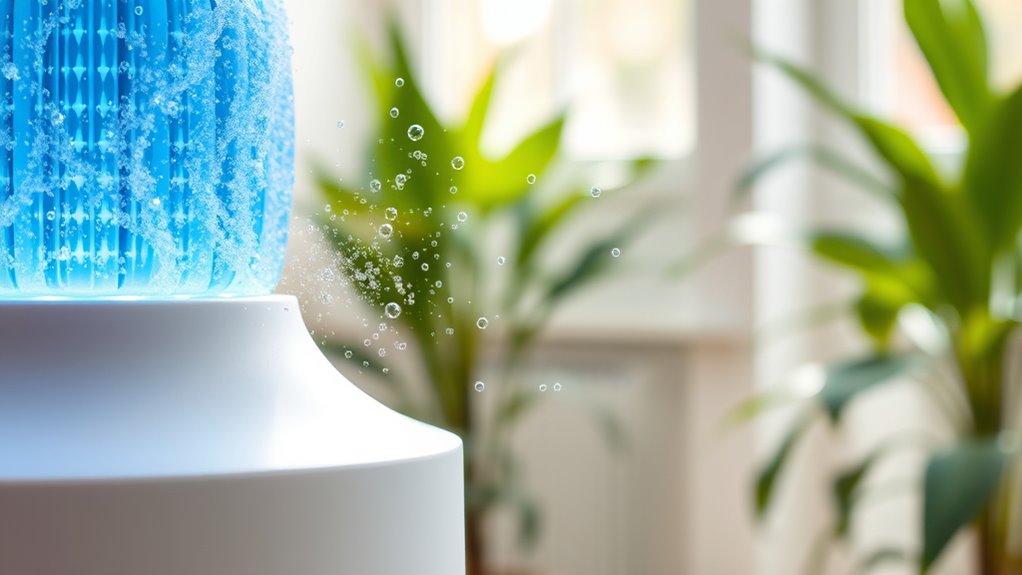
Ionizer air purifiers work by releasing negatively charged ions into the air, which attach to airborne particles like dust, pollen, and smoke. This process is a form of air purification that relies on ionization technology to improve indoor air quality. When these ions attach to particles, they cause them to become heavier and fall out of the air or stick to surfaces, effectively removing contaminants from your environment. Unlike filters, ionization technology doesn’t require physical replacement parts, making it low-maintenance. The ions produced actively seek out pollutants, ensuring continuous air cleaning. This method is efficient for reducing airborne allergens and particles, making your space cleaner and healthier. Understanding how ionizer air purifiers work helps you make informed decisions about their use for safer indoor air. However, it is also important to consider the potential production of ozone, which can be harmful in high concentrations. Manufacturers often incorporate safety features or ozone emission limits to minimize health risks, and some models include ozone emission controls to ensure safer operation. Additionally, air purifier safety guidelines recommend proper placement and usage to reduce any potential health concerns related to ozone. Furthermore, awareness of ozone levels in your environment can help prevent overexposure and ensure safe operation of your air purifier.
What Is Ozone and Why Is It a Concern?
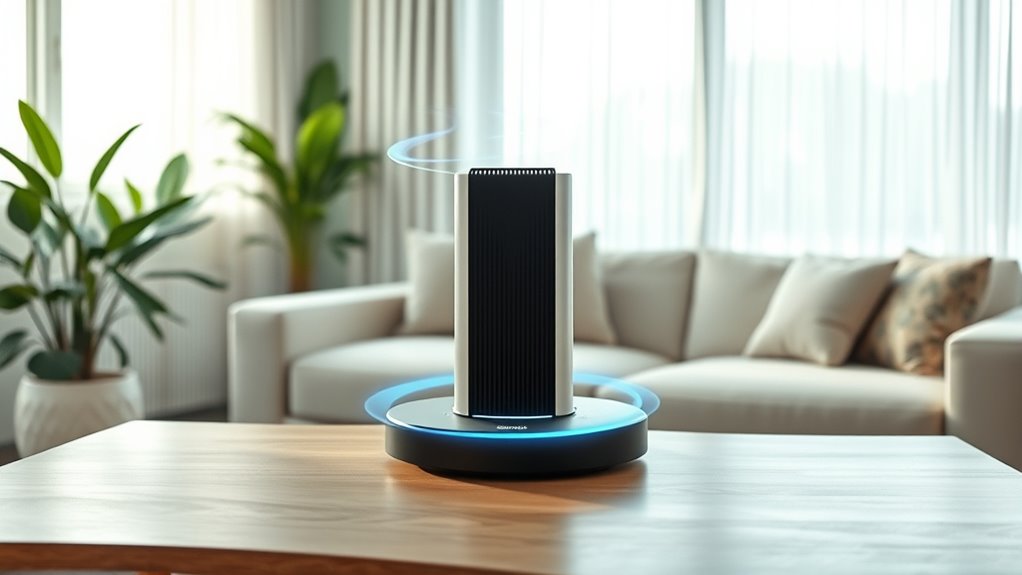
Ozone is a reactive form of oxygen that can impact your health when present indoors. It can cause respiratory problems and other health issues, especially at elevated levels. Understanding its chemical nature and how indoor ozone levels affect you is essential for safe air purification. Exposure to high ozone levels can also lead to grocery savings strategies, as some air purifiers may be marketed with health claims that require careful evaluation.
Ozone’s Chemical Nature
Ozone is a molecule composed of three oxygen atoms, making it a highly reactive form of oxygen. Its chemical stability is low, which means it readily participates in oxidation reactions. This reactivity allows ozone to break down pollutants and kill bacteria effectively. However, it also means ozone can damage biological tissues and materials when present in high concentrations. Because of its oxidative power, ozone reacts quickly with other substances, often producing secondary pollutants. These reactions can alter the chemical composition of indoor air, sometimes creating harmful byproducts. While ozone’s ability to oxidize makes it useful for air purification, it also raises concerns about potential health risks. Understanding ozone’s chemical nature helps you recognize why controlling its levels is vital for safe air cleaning.
Health Impact Risks
Although ozone can effectively neutralize airborne pollutants, it also poses significant health risks when inhaled. Exposure to ozone can irritate your respiratory system, causing coughing, throat irritation, and shortness of breath. Long-term exposure increases the risk of developing chronic respiratory diseases, such as asthma. You should be aware of these dangers before using ionizer air purifiers that produce ozone. Key health risks include:
- Respiratory inflammation and reduced lung function
- Aggravation of existing asthma and lung conditions
- Increased vulnerability to respiratory infections
These health risks are especially concerning if you’re exposed repeatedly or for extended periods. Protect yourself by understanding the potential dangers associated with ozone, particularly when considering devices that generate it during operation. Additionally, the contrast ratio of a projector can influence how well dark scenes are rendered, which is important for creating an immersive viewing experience. Moreover, understanding the science of ozone formation can help you make safer choices regarding air purification options, especially when evaluating models with ozone-generating features. Being aware of ozone production mechanisms can further aid in avoiding unintended health hazards.
Indoor Ozone Levels
Because ozone is a reactive gas that can easily mix with indoor air, it can substantially elevate indoor ozone levels when produced by air purifiers. Elevated ozone levels can worsen indoor pollutants, such as dust, mold spores, and volatile organic compounds, by reacting with these substances to form harmful byproducts. Poor air circulation can trap ozone indoors, increasing your exposure over time. This buildup raises concerns because high ozone levels can irritate your respiratory system, trigger asthma symptoms, and harm lung tissue. Even if an air purifier claims to reduce airborne pollutants, producing ozone might compromise indoor air quality. To keep your indoor environment safe, it’s essential to comprehend how ozone can accumulate and ensure proper ventilation when using ionizer air purifiers.
Do All Ionizer Purifiers Produce Ozone?
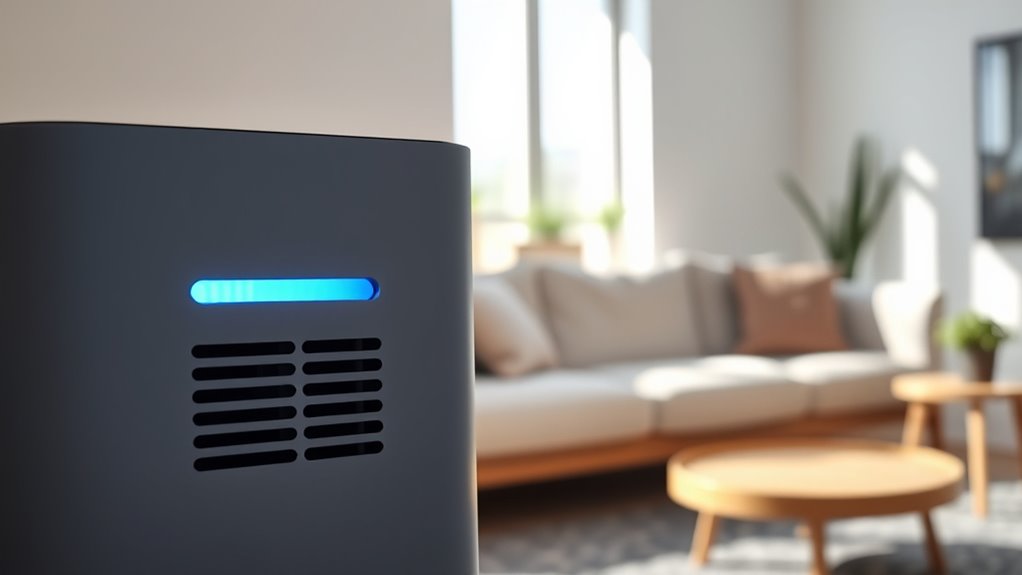
Not all ionizer air purifiers produce ozone, but many do as a byproduct of their cleaning process. The amount of ozone generated varies widely, making Ozone measurement vital for safety. Some models create minimal ozone below safety thresholds, while others produce levels that could be harmful. To determine safety, check the manufacturer claims about ozone emissions and verify with independent tests. Keep an eye on product labels and specifications for ozone output information. Be aware that even low ozone levels can accumulate in enclosed spaces. Here are key points to consider:
Not all ionizer air purifiers produce ozone; check emissions and verify safety through independent testing.
- Different ionizer models emit varying ozone levels
- Manufacturer claims may not always reflect real-world ozone production
- Ozone measurement is crucial for assessing safety and compliance
- Indoor air quality can be affected by ozone emissions, impacting health and comfort. Additionally, understanding the environmental impact of ozone production can help consumers make informed choices about air purification devices. Recognizing regulatory standards and industry guidelines can further aid in selecting safer air purifiers. Incorporating advanced testing methods can ensure more accurate detection of ozone levels in consumer products. Utilizing reliable measurement devices is essential for consumers who want to monitor ozone levels in their homes and ensure safety.
Factors That Influence Ozone Emission Levels
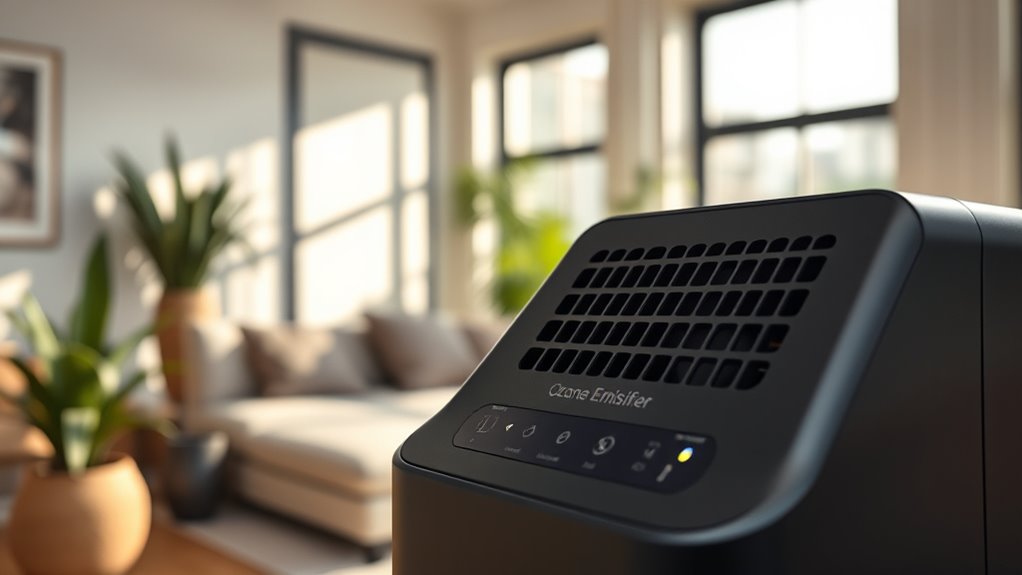
Several factors influence the amount of ozone an ionizer air purifier emits, and understanding these can help you assess safety. Manufacturing variability plays a role; different units may produce varying ozone levels due to differences in design or quality control. Additionally, room ventilation considerably impacts ozone concentration. Poor ventilation allows ozone to accumulate, increasing potential health risks, while well-ventilated spaces help disperse ozone more effectively. The size of the room also matters—smaller spaces tend to concentrate ozone more than larger ones. Proper air circulation can further help in dispersing ozone, reducing buildup in indoor environments. Moreover, grooming trends emphasizing sustainability and eco-friendly practices highlight the importance of choosing safe and environmentally conscious air purification options. Considering industry standards and safety guidelines can also help ensure your air purifier operates within safe ozone emission levels. Ensuring proper device maintenance can prevent excessive ozone production due to malfunctions or aging components. By considering manufacturing differences and ensuring proper room ventilation, you can better manage ozone levels and reduce potential exposure, making your use of an ionizer air purifier safer and more effective.
Safety Standards and Regulations for Ozone in Air Purifiers
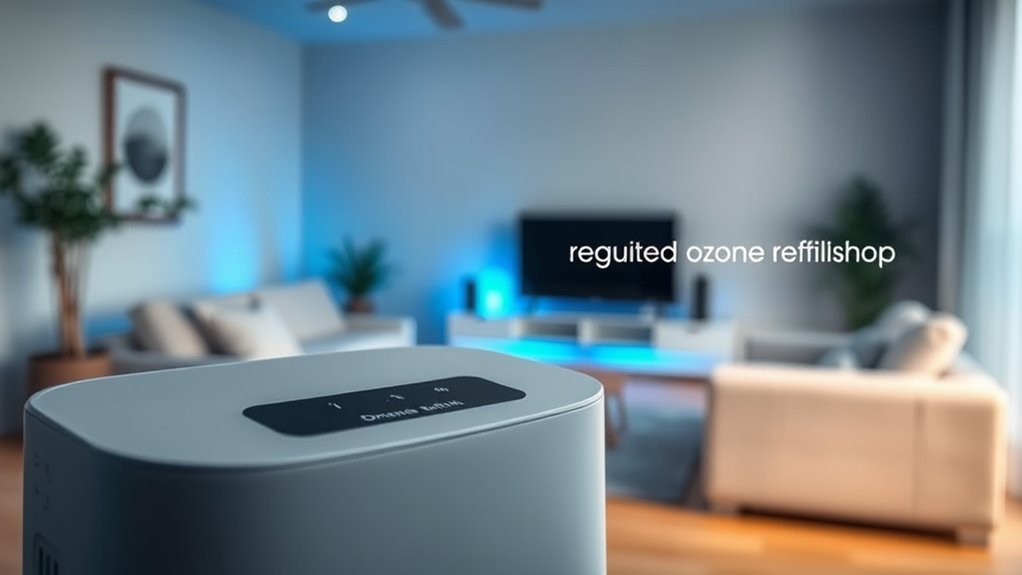
Safety standards and regulations for ozone in air purifiers are established to protect consumers from potential health risks associated with ozone exposure. Regulatory standards set clear emission limits to ensure that air purifiers don’t produce unsafe ozone levels. These standards are enforced by agencies like the FDA and EPA, which monitor manufacturer compliance. Knowing these regulations helps you identify safe products that meet legal requirements.
Regulatory standards ensure air purifiers produce safe ozone levels, protecting consumers from health risks.
- Devices must adhere to strict emission limits to minimize ozone production
- Manufacturers are required to label ozone emission levels clearly
- Regulatory standards ensure that ozone levels stay below thresholds linked to health concerns
Tips for Choosing a Safe and Effective Ionizer Air Purifier
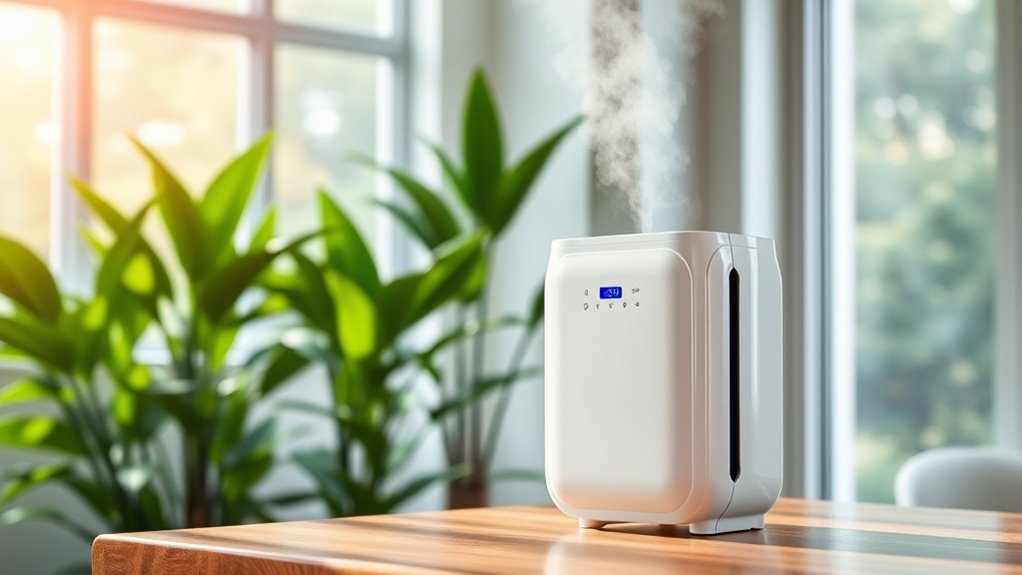
Choosing a safe and effective ionizer air purifier requires paying close attention to emission levels and certification labels. Look for units with low ozone output and certifications from reputable agencies to ensure good air quality. Regular purifier maintenance is essential to keep it functioning efficiently and prevent the buildup of harmful pollutants. To help you select the right model, consider this comparison:
| Feature | Importance | What to Check |
|---|---|---|
| Ozone Emissions | Ensures safety and air quality | Certified low or zero ozone output |
| Certification Labels | Validates safety and effectiveness | Look for CARB or UL labels |
| Maintenance Needs | Maintains purifier efficiency | Easy-to-clean components |
Prioritize these factors to ensure your ionizer improves air quality safely and reliably. Additionally, understanding trailer music composition techniques can help you appreciate how sound design influences perceptions of air quality in promotional content. Recognizing emission levels is crucial for assessing the health risks associated with ozone production from ionizers. Furthermore, awareness of public health guidelines can assist you in choosing devices that comply with safety standards and recommendations. Being aware of product safety standards and how they are established can provide additional assurance of a device’s reliability and safety. Staying informed about air quality monitoring can also help you make better decisions about when and how to use your purifier effectively.
Frequently Asked Questions
Are There Health Risks Associated With Low Ozone Emissions From Ionizer Purifiers?
You might wonder about health implications of low ozone emissions from ionizer purifiers. While these devices produce minimal ozone, ongoing ozone exposure can cause respiratory issues, throat irritation, or worsen asthma. Even low levels could pose risks over time, especially for sensitive individuals. It’s wise to guarantee proper ventilation and choose purifiers with verified low ozone output to minimize health concerns related to ozone exposure.
How Can Consumers Identify Ozone-Free Ionizer Air Purifiers?
Imagine walking into a fresh, clean room, feeling confident about the air you breathe. To identify ozone-free ionizer air purifiers, look for certification labels like CARB compliance or UL listings on the product. Check the product specifications for ozone emission levels, ensuring they’re at zero or negligible. These indicators help you choose devices that purify your air safely without producing harmful ozone, giving you peace of mind in your space.
Do Manufacturer Claims About Ozone Levels Always Match Real-World Emissions?
You should be cautious because manufacturers’ claims about ozone levels don’t always match real-world emissions. They often rely on ozone measurement tests that may not reflect typical use conditions. While some claim their ionizer air purifiers produce minimal or no ozone, actual emissions can vary. Always check independent reviews and certified ozone measurement results to verify you’re choosing a safe device that aligns with your health concerns.
Can Ionizer Air Purifiers Be Used Safely in Homes With Pets or Children?
Imagine an air purifier quietly working in the corner of your home, creating a cleaner space for your family and pets. You wonder if ionizer air purifiers are safe with pets and children around. While they can improve air quality, some emit low levels of ozone, which may concern pet safety. Always choose models with verified low ozone emissions, and guarantee proper ventilation to keep everyone safe.
Are There Alternative Air Purification Technologies Without Ozone Production Concerns?
If you’re concerned about ozone, consider air purifiers with HEPA filters and activated carbon. HEPA filters effectively trap airborne particles like dust, pollen, and pet dander without producing ozone. Activated carbon absorbs odors and VOCs safely. These technologies offer cleaner air without ozone worries, making them safer choices for homes with children and pets. You get effective purification while avoiding potential ozone-related health issues.
Conclusion
Knowing whether ionizer air purifiers produce ozone helps you make safer choices. Did you know that some models emit ozone levels exceeding safety standards? By understanding how they work and what to look for, you can select an air purifier that keeps your air clean without risking ozone exposure. Always check for certifications and follow manufacturer guidelines. With the right information, you can breathe easier and enjoy a healthier home environment.

